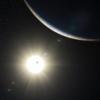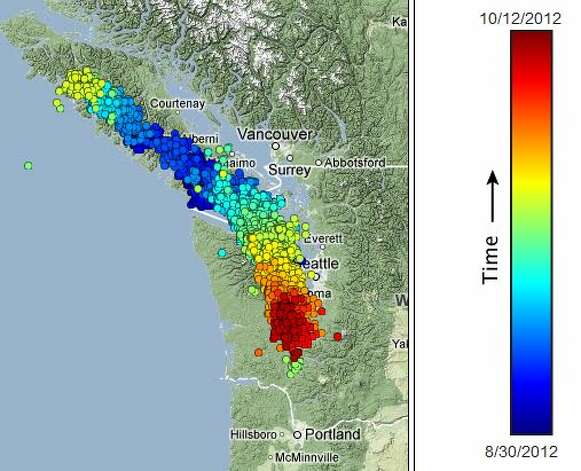

| Visitors Now: | |
| Total Visits: | |
| Total Stories: |

By Extinction Protocol: 2012 Earthchanges and News Event (Reporter)
Contributor profile | More stories
Contributor profile | More stories
| Story Views | |
| Now: | |
| Last Hour: | |
| Last 24 Hours: | |
| Total: | |
California quake model looks for ‘mega-quake’ along Cascadia
Friday, January 11, 2013 7:10
% of readers think this story is Fact. Add your two cents.
January 11, 2013 – PORTLAND, Or. - New research is giving us some insight into when a major earthquake could strike the Northwest. The research was done in part by Stanford geophysics Professor Paul Segall. He has been tracking a series of very small tremors that rumble deep within the earth. The slow tremors happen roughly every summer along the Cascadia Subduction Zone, an undersea fault about 70 miles off the Oregon Coast. Over the last decade, data shows the tremors have been getting progressively bigger. Last summer, the Pacific Northwest experienced a notably large one. Experts believe those tremors are adding stress to the offshore fault. Using this data, Segall built a computer model which suggests it will be one of those tiny quakes that triggers a major magnitude 9 earthquake. “What we do see is that ultimately one of these tends to develop into a fast and potentially, damaging earthquake,” said Segall. Segall said that scientists don’t yet know how big those tremors need to get before they explode into a mega-thrust quake. And that means a major earthquake in the Pacific Northwest could still be hundreds of years away. But, he added, those tiny tremors are a good reminder that we always need to be prepared. Scientists discover the largest-known spiral galaxy. –King 5
 San Andreas stress rupture could shake entire state: For the first time, scientists and emergency planners are examining whether a super quake could affect both Northern and Southern California, rendering the entire state helpless in the aftermath of the “Big One.” Seismologists have warned Southern California that a major quake on the lower San Andreas Fault, the so-called Big One is inevitable. But that the population centers of both Southern and Northern California could be affected simultaneously by one quake on the San Andreas Fault has only recently been recognized as a possibility. The study by Professor Nadia Lapusta at the California Institute of Technology (Caltech) and Japanese collaborator Hiroyuki Noda focused on explaining the behavior of two devastating quakes in Asia: the 1999 magnitude 7.6 temblor in Taiwan, and the 2011 magnitude 9.0 quake off the eastern coast of Japan. In both cases, the quake spread across so-called “creeping“ fault segments long thought to be incapable of transmitting quakes, according to Caltech Staff Seismologist Kate Hutton, a Lapusta colleague. “The general idea until this paper was that they would stop a quake,” Hutton said. It was believed the slow, creeping movement prevents stress from building up and keeps such a segment stable, Hutton added. Lapusta and Noda developed a computer model to explain how under certain conditions “a rupture could just kind of barge right through,” Hutton said. “Now the question is how this would apply to California.” Such a creeping zone has been identified in a stretch of the San Andreas Fault in central California, just north of seismically active Parkfield. The Great San Francisco quake of 1906 occurred on the San Andreas north of the creeping zone. The 1857 Fort Tejon quake occurred to the south. No known quake has ever spanned across that creeping zone. Whether the model developed by Lapusta and Noda could apply there would depend on local geological variables not yet completely understood, Hutton said. –NBC LA
San Andreas stress rupture could shake entire state: For the first time, scientists and emergency planners are examining whether a super quake could affect both Northern and Southern California, rendering the entire state helpless in the aftermath of the “Big One.” Seismologists have warned Southern California that a major quake on the lower San Andreas Fault, the so-called Big One is inevitable. But that the population centers of both Southern and Northern California could be affected simultaneously by one quake on the San Andreas Fault has only recently been recognized as a possibility. The study by Professor Nadia Lapusta at the California Institute of Technology (Caltech) and Japanese collaborator Hiroyuki Noda focused on explaining the behavior of two devastating quakes in Asia: the 1999 magnitude 7.6 temblor in Taiwan, and the 2011 magnitude 9.0 quake off the eastern coast of Japan. In both cases, the quake spread across so-called “creeping“ fault segments long thought to be incapable of transmitting quakes, according to Caltech Staff Seismologist Kate Hutton, a Lapusta colleague. “The general idea until this paper was that they would stop a quake,” Hutton said. It was believed the slow, creeping movement prevents stress from building up and keeps such a segment stable, Hutton added. Lapusta and Noda developed a computer model to explain how under certain conditions “a rupture could just kind of barge right through,” Hutton said. “Now the question is how this would apply to California.” Such a creeping zone has been identified in a stretch of the San Andreas Fault in central California, just north of seismically active Parkfield. The Great San Francisco quake of 1906 occurred on the San Andreas north of the creeping zone. The 1857 Fort Tejon quake occurred to the south. No known quake has ever spanned across that creeping zone. Whether the model developed by Lapusta and Noda could apply there would depend on local geological variables not yet completely understood, Hutton said. –NBC LA
Countdown to a catastrophic mega-quake in the U.S.
2013-01-11 06:48:19
Source:



